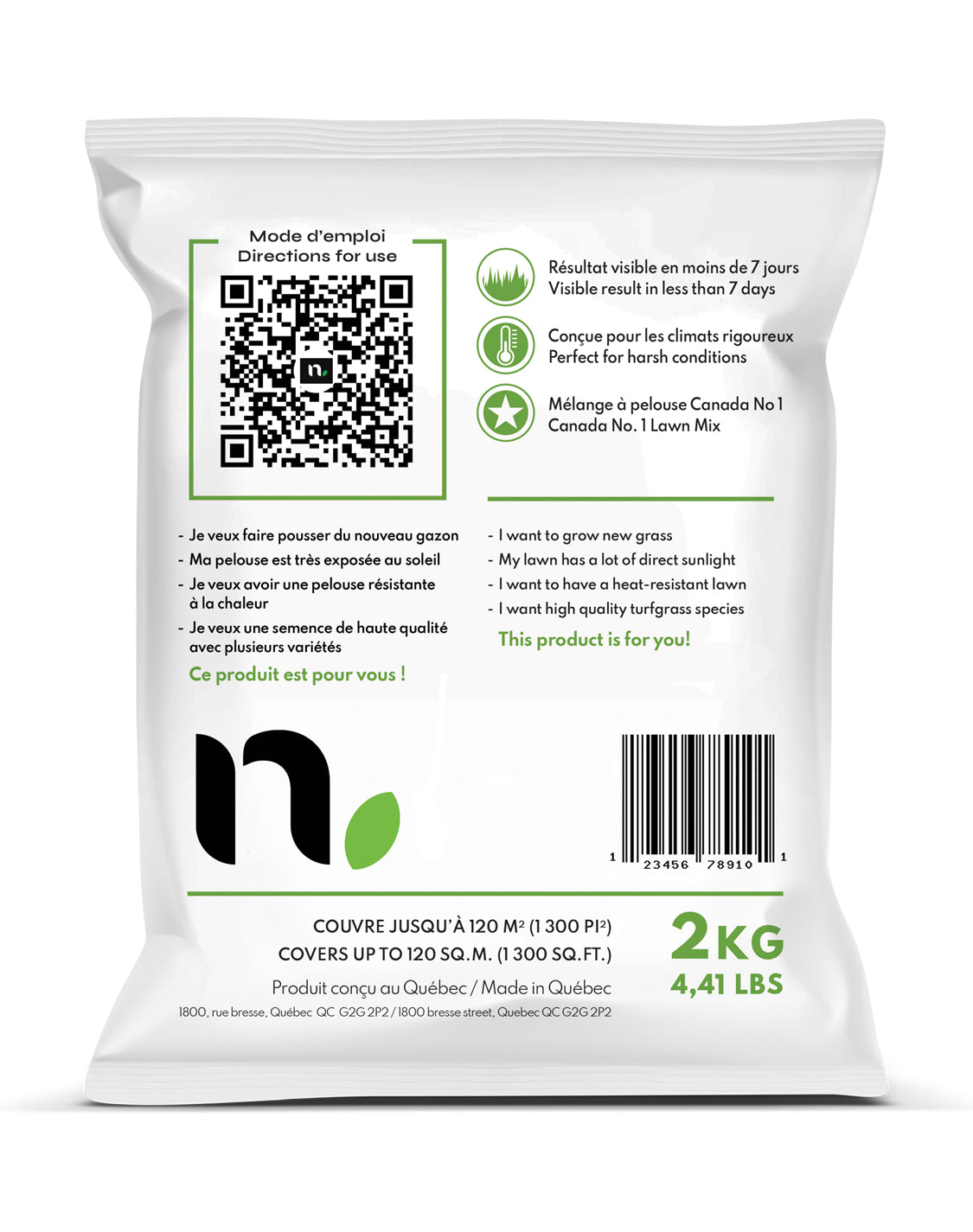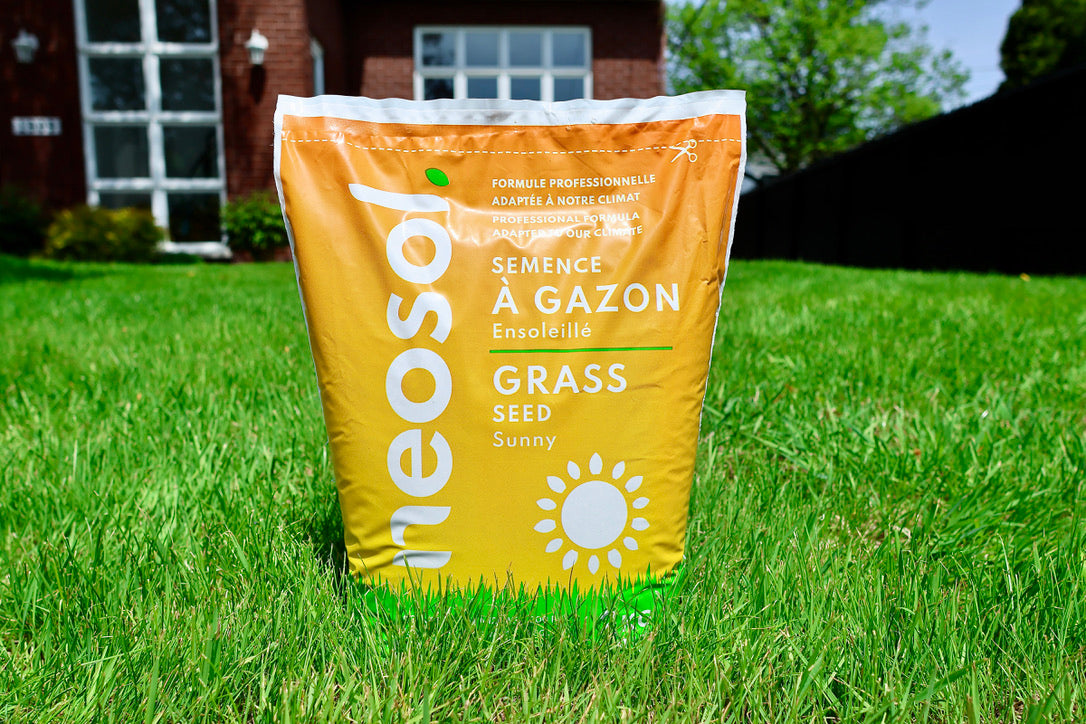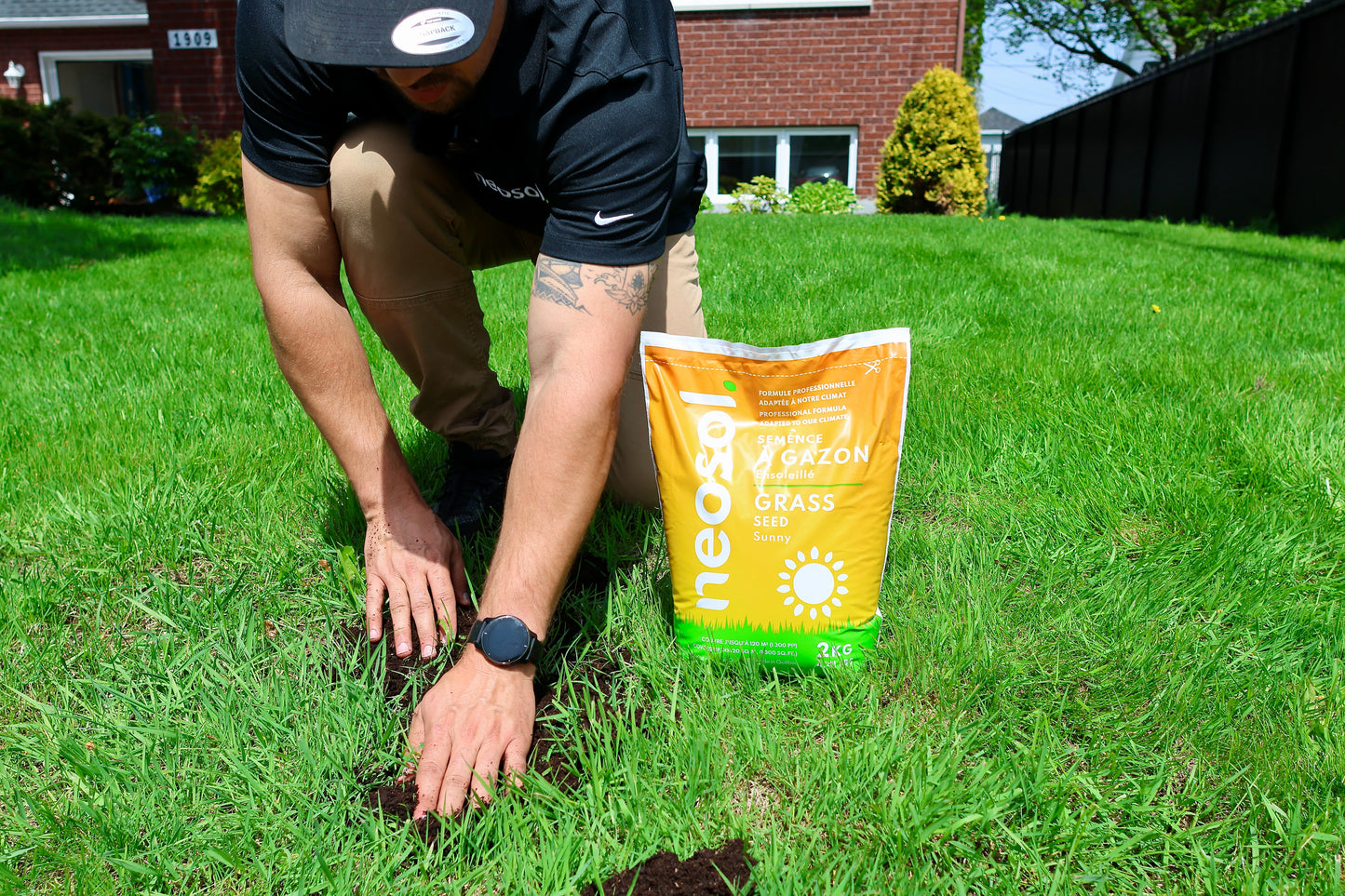Neosol Lawncare
Sun grass seed - 2kg
Sun grass seed - 2kg
Couldn't load pickup availability
 Visible result in less than 7 days
Visible result in less than 7 days
 Designed for harsh climates
Designed for harsh climates
 Canada No. 1 Certified Lawn Mix
Canada No. 1 Certified Lawn Mix
-
Perfect for very sunny locations
-
Perfect for surfaces subject to heavy foot traffic
Description
Soleil Neosol seed allows you to obtain a new lawn very quickly. The density improves in less than 7 days, the lawn becomes more resistant to trampling and drought, and having a dense lawn allows you to have a lawn with fewer weeds. The mixture contains the best seeds in terms of quality.
New seed coverage: 2 kg covers 75 m2 / 810 ft2
Reseeding coverage: 2 kg covers 120 m2 / 1300 ft2
Mélange
Mélange
Recipe
35% Esquire perennial ryegrass
20% Kentucky bluegrass sr2100
5% brahms turf fescue
40% starlett tall fescue
Utilisation
Utilisation
Repairing dead grass patches / Repairing dead grass patches
- Mow the lawn very short, about 2 in.
- Rake yellowed or damaged lawn
- Pull out as many weeds as possible
- Spread a 1/2-inch thick layer of seed compost over the entire desired surface.
- Spread the seeds evenly.
- Add a layer of potting soil about 1/4 inch over the entire surface.
- Keep the soil moist until the lawn is established (without waterlogging), for about 20 days. The spray should be gentle so as not to wash away the seeds.
- Mow the lawn when it is about 4 inches tall.
Re-seed and overseed
Reseeding helps increase the density of your lawn and reduce weed growth.
- Aerate the soil (ideally)
- Mow the lawn very short, about 5 cm (2 in)
- Pull out as many weeds as possible.
- Spread the seeds evenly, making sure they come into contact with the soil.
- Keep the soil moist until the lawn is established (without saturating it with water), for about 20 days.
Seeding a new lawn
- Clear the surface of any debris.
- Spread a 4 to 6 inch layer of potting soil over the entire surface
-Spread the seeds evenly.
-Add a layer of potting soil about 1/4 inch over the entire surface.
-Keep the soil moist until the lawn is established (without it being saturated with water), for about 20 days. The jet must be weak so as not to carry away the seeds.
-Mow the lawn when it has reached a height of approximately 4 inches.
Livraison
Livraison
Gratuite avec tout achat de 125$ et plus.
Partager




FAQ
When to sow?
Spring :
When?: From mid-April to mid-June.
Advantages: The soil warms up, and temperatures are moderate, which promotes rapid germination and good growth of young plants. In addition, spring rains help keep the soil moist.
Disadvantages: Competition with weeds may be more intense, and regular watering may be necessary if the spring is dry.
Late summer to early fall:
When?: From mid-August to the end of September.
Pros: Temperatures are still warm, but nights are getting cooler, creating ideal conditions for grass germination and establishment. There is generally less competition from weeds, and the soil stays moist thanks to fall rainfall.
Disadvantages: Time for establishment before winter sets in is limited, so it is crucial to sow early enough to allow young plants to root.
By seeding in spring or late summer, you give your lawn the best chance to establish and thrive.
How to sow a new lawn?
- Clear the surface of any debris.
- Spread a 4 to 6 inch layer of potting soil over the entire surface
-Spread the seeds evenly.
-Add a layer of potting soil about 1/4 inch over the entire surface.
-Keep the soil moist until the lawn is established (without it being saturated with water), for about 20 days. The jet must be weak so as not to carry away the seeds.
-Mow the lawn when it has reached a height of approximately 4 inches.
How to seed a new lawn or overseed?
- Aerate the soil (ideally)
- Mow the lawn very short, about 5 cm (2 in)
- Pull out as many weeds as possible.
- Spread the seeds evenly, making sure they come into contact with the soil.
- Keep the soil moist until the lawn is established (without saturating it with water), for about 20 days.
How to repair dead grass patches / repair dead grass patches?
- Mow the lawn very short, about 2 in.
- Rake yellowed or damaged lawn
- Pull out as many weeds as possible
- Spread a 1/2-inch thick layer of seed compost over the entire desired surface.
- Spread the seeds evenly.
- Add a layer of potting soil about 1/4 inch over the entire surface.
- Keep the soil moist until the lawn is established (without it being saturated with water), for about 20 days. The jet must be weak so as not to carry away the seeds.
- Mow the lawn when it has reached a height of approximately 4 inches.
How to use grass seed with other products?
Seed should be applied 5 to 7 days after using a herbicide. Herbicide should not be applied to new seedlings until four weeks after seeding. Fertilizer can be applied before, during, or after seeding. Insecticide can be applied before, during, or after seeding.
How long does it take before you see some grass?
With the composition of the seed mix, germination times may vary depending on the grass species included. Here is an overview of typical germination times for each type of seed in our mix.
Perennial ryegrass (35%): 5 to 10 days
Kentucky Bluegrass (20%): 14 to 21 days
Grass fescue (5%): 7 to 14 days
Tall fescue (40%): 10 to 14 days
Estimated first shoots:
Since perennial ryegrass is the dominant species and has the shortest germination time, you can expect to see the first perennial ryegrass shoots appear in about 5 to 10 days after sowing. The other species will follow:
Perennial ryegrass: 5 to 10 days
Grass fescue and tall fescue: 7 to 14 days
Kentucky Bluegrass: 14 to 21 days
Conclusion :
You should start to see the first shoots of your lawn in about 5-10 days, mainly due to the rapid germination of the perennial ryegrass. The other species will complement the mix and contribute to a dense, robust lawn as they germinate and grow.
What sets sun seed apart from other seeds?
Benefits of Neosol Sun Seed for Sports Fields and Full Sun
Composition of Neosol Soleil seed:
Perennial ryegrass (35%)
Kentucky Bluegrass (20%)
Grass fescue (5%)
Tall fescue (40%)
1. Perennial ryegrass (35%):
Quick germination: Grass begins to appear within 5 to 10 days, providing rapid soil coverage.
Trampling resistance: Ideal for sports fields with high traffic, as it tolerates heavy trampling well.
Adaptability: Adapts well to different soil and climate conditions.
2. Kentucky bluegrass (20%):
Durability: Forms a dense, durable turf, perfect for sports fields.
Stress Resistance: Excellent heat and drought resistance, making it ideal for areas with full sun.
Rapid Recovery: Ability to regenerate quickly after periods of stress or damage.
3. Grass fescue (5%):
Shade Tolerance: Although a minority in the mix, it adds some shade tolerance, improving the versatility of the turf.
Disease Resistance: Good resistance to common turf diseases, contributing to a healthy, robust lawn.
4. Tall fescue (40%):
Drought Resistance: Highly drought tolerant, it helps maintain a green lawn even in arid conditions.
Trampling Tolerance: Good resistance to trampling, essential for heavily used sports fields.
Deep Root System: Develops a deep root system, improving turf stability and durability.
Overall product benefits:
Fast results: Quick germination thanks to the significant presence of perennial ryegrass, providing rapid soil cover.
Adaptability to sunny conditions: The selected species are all adapted to areas in full sun, guaranteeing a dense and resistant lawn.
Durability and resistance: The mixture is designed to withstand heavy traffic, heat and drought, making it ideal for sports fields and harsh weather conditions.
Turf Health: The combination of these grasses ensures a green, dense, weed-free lawn with good disease tolerance and excellent regeneration capacity.
In short, Neosol Soleil seed is specially formulated to provide a robust, green and durable lawn, perfectly suited to sports fields and areas in full sun, thanks to its balanced composition and multiple advantages.








